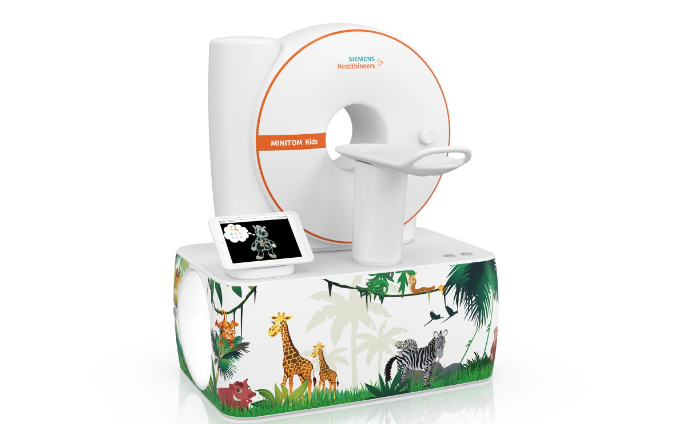
September marks Childhood Cancer Awareness Month (CCAM), a time dedicated to raising awareness and support for children battling cancer. At Centella, we are committed to highlighting the significant advancements in medical imaging that have revolutionized the diagnosis and treatment of pediatric cancers. Early imaging can contribute to cancer diagnosis and expanding treatment options, offering new hope to children with cancer and their families.
These advancements in medical imaging are enhancing our ability to detect various types of cancer in pediatric patients, allowing for more personalized and targeted treatments. Explore the latest innovations in medical imaging and their impact on pediatric cancer treatment, highlighting the importance of ongoing support and research for young patients.
Differences Between Adult and Child Cancer Treatments
Treating cancer in children differs significantly from treating cancer in adults. Pediatric cancers often arise from different cellular origins compared to adult cancers, necessitating unique treatment approaches. Children’s bodies are still developing, which means their tolerance to treatments like chemotherapy and radiation can differ from that of adults.
Moreover, the side effects of cancer treatments can impact children differently, often affecting their growth and development. As a result, pediatric cancer treatments must be carefully tailored to minimize long-term harm while effectively targeting the cancer. Advanced imaging technologies play a crucial role in this process by providing detailed insights into the tumor’s location, size, and response to treatment, enabling more precise and less invasive interventions.
In pediatric oncology, the goal is to treat the cancer and ensure the best possible quality of life for the child during and after treatment. This requires a multidisciplinary approach, combining the expertise of oncologists, radiologists, surgeons, and supportive care specialists to address the unique needs of children with cancer.
You can refer to the American Cancer Society for more detailed information on the differences between adult and child cancer treatments.

Innovations in Pediatric Imaging
Magnetic Resonance Imaging (MRI) Advances: Enhancing Precision in Pediatric Cancer Care
Functional MRI (fMRI): Enhancing Surgical Planning in Pediatric Cancer
Functional MRI (fMRI) represents a significant advancement in pediatric oncology. By measuring brain activity through changes in blood flow, fMRI helps map critical areas of the brain. This precision is particularly important when planning surgeries for brain tumors, as it aids in preserving vital functions like movement and speech. For children undergoing such complex procedures, preserving these functions can greatly impact their quality of life after treatment.
3D MRI: Bringing Clarity to Childhood Tumor Diagnosis and Monitoring
3D MRI provides highly detailed imaging, making it an essential tool for diagnosing and monitoring tumor progression. This clarity can assist oncologists in developing more targeted treatment plans, focusing on the tumor while reducing the impact on surrounding healthy tissue. The enhanced visualization helps support more informed decision-making, offering significant benefits for pediatric care.
Positron Emission Tomography (PET) Scans: A Closer Look at Tumor Activity
PET-MRI combines the insights of PET scans with the detailed imaging of MRI to offer a comprehensive view of tumor activity. This non-invasive diagnostic technique uses specific radiotracers to produce highly detailed images of the body and measure functions such as blood flow, oxygen use, and sugar metabolism. By evaluating how a child’s tissues or organs function, PET-MRI helps assess how cancers respond to therapy. This integrated approach enables healthcare providers to make real-time adjustments to treatment. (Dana-Farber Cancer Institute).
Ultrasound and Fetal Echocardiography: Early Detection and Intervention in Pediatric Health
Advanced ultrasound technologies, including fetal echocardiography, play a crucial role in detecting congenital heart disease and other anomalies early in pregnancy. Congenital heart defects are the most common type of birth defect, affecting nearly 1% of births per year in the United States (American Heart Association). Early detection helps healthcare providers plan timely interventions and prepare for the specialized care the child may need at birth. This proactive approach aids in addressing these conditions promptly. These technologies can help aid in managing childhood cancers that can impact cardiac function, as some cancer treatments can have cardiac side effects. Identifying cardiac anomalies early allows for the implementation of treatment strategies, allowing for care tailored to the child’s specific needs.
Digital Radiography: Modern Imaging Techniques for Pediatric Patients
Radiation exposure is a primary concern in pediatric imaging as it may lead to later complications. Innovations in digital radiography have addressed this issue by reducing the radiation dose required for imaging. These advancements aim to minimize the risk associated with radiation exposure. By balancing reduced radiation exposure with enhanced image quality, digital radiography provides doctors with the detailed information needed for accurate diagnosis and treatment planning.
Advances in Childhood Cancer Treatment
Personalized Medicine: Customized Approaches for Pediatric Cancer Treatment
Genomic Testing: Tailoring Cancer Treatment to Each Child’s Unique Genetic Profile
Genomic testing aids in identifying specific genetic mutations present in a child’s tumor. By understanding the unique genetic makeup of the cancer, healthcare providers can develop personalized treatment plans that precisely target the tumor’s characteristics. This tailored approach helps choose therapies most likely to benefit the individual patient.
Targeted Therapies: Focusing Treatment on Cancer Cells While Preserving Healthy Tissue
Targeted therapies focus on attacking cancer cells while sparing healthy cells. By specifically targeting the molecular markers of the cancer cells, these therapies can provide a treatment plan that aligns with the child’s unique condition and needs.
Immunotherapy: Harnessing the Body’s Immune System to Fight Pediatric Cancer
CAR-T Cell Therapy is an innovative treatment that modifies a patient’s T-cells to recognize and attack cancer cells. It has shown particularly promising results in treating certain types of pediatric cancers, such as acute lymphoblastic leukemia (ALL). ALL is the most common type of cancer in children, and CAR-T cell therapy offers a targeted approach for those who may not respond to standard treatments. By harnessing the body’s immune system to specifically target leukemia cells, this therapy provides a new avenue of hope for children with relapsed or refractory ALL (Dana-Farber Cancer Institute).
Proton Beam Therapy: Precision Radiation for Sensitive Pediatric Cancers
Proton beam therapy delivers precisely targeted radiation to tumors, minimizing exposure to the surrounding healthy tissue. This approach is especially advantageous for treating cancers located in sensitive areas such as the brain and spine, where traditional radiation may pose higher risks. By concentrating the radiation dose on the tumor itself, proton beam therapy aims to reduce potential long-term side effects.

Reducing Anxiety in Pediatric Imaging
Undergoing medical imaging can be a stressful experience for children, often exacerbated by the cold and clinical atmosphere of examination rooms. Recent efforts in pediatric radiology have focused on reducing anxiety by creating more welcoming and comforting environments. Innovations in imaging spaces include child-friendly designs like colorful murals, adjustable lighting, and interactive elements like toys or video projections. One creative approach involves the introduction of Gerda, the brave giraffe, developed by a multidisciplinary team to make imaging examinations like MRI, CT, and fluoroscopy less stressful for children. By engaging closely with the target group of 3- to 9-year-olds, Gerda was created as a comforting and familiar presence, helping to transform a potentially frightening experience into a more manageable and even engaging one for young patients (Siemens Healthineers).
Additionally, efforts are being made to streamline imaging procedures to minimize the time children spend in these environments. Techniques such as play therapy have been shown to significantly reduce anxiety, emotional distress, and even pain perception in hospitalized children with cancer. Recent studies by the Journal Of Nursing Practice show that play therapy provides a therapeutic outlet for children to express their emotions, cope with the hospital environment, and gain a sense of control. When combined with age-appropriate explanations of procedures, these strategies help to ease a child’s anxiety, making medical imaging a less daunting experience.
By prioritizing the emotional well-being of young patients, healthcare providers can ensure a smoother imaging process, which can lead to more accurate results and a more positive overall experience for both children and their families.

The Impact of Medical Imaging on Child Cancer Treatment
The advancements in medical imaging are crucial for the effective treatment of childhood cancer, providing essential support for early and accurate diagnosis. These technologies assist in identifying and monitoring pediatric conditions, supporting the development of personalized treatment plans. The role of medical imaging in pediatric healthcare cannot be overstated, as it ensures that children receive the best possible medical care.
Visit the National Cancer Institute for further information on the importance of medical imaging in treating childhood cancer.
As we continue to innovate and support research in pediatric oncology, reliable and advanced medical imaging equipment is vital. Centella is and advanced partner of Siemens Healthineers and offers the latest technology to providers in South Florida for top-tier care for pediatric patients.
Contact Us to learn more about how Centella can support your medical imaging needs.
